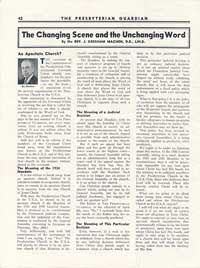A Plan of Action for Revival
If you look at some of the early Presbyterian Guardian issues on-line, you will notice on the masthead the name of the Constitutional Covenant Union. What was this organization?
The Constitutional Covenant Union was an independent agency organized after the 1935 General Assembly of the Presbyterian Church, U.S.A. That national meeting brought some powerful indications that the conservative Presbyterians days were numbered in the visible church. So there went out a call to the supporters of the true Presbyterians to come to Philadelphia for a meeting on June 27, 1935. Over one hundred people answered the call. The Constitutional Covenant Union was organized, with officers elected, an executive committee named, and a constitution adopted. Chapters were to be organized, and a program of reform of the Presbyterian Church USA promoted.
That program was set introduced by an opening statement. The purposes were two-fold. It said, “we, the members of this Covenant Union are resolved, in accordance with God’s Word and in humble reliance upon His grace, to maintain the Constitution of the Presbyterian Church in the USA, (1) making every effort to bring about a reform of the existing church organization and to restore the church’s clear and glorious Christian testimony, which modernism and indifferentism have now so grievously silenced, but (2) if such efforts fail, and in particular, if the tyrannical policy of the present majority triumphs, holding ourselves ready to perpetuate the true Presbyterian Church, USA, regardless of cost.”
The meeting in Philadelphia would last from June 11 to June 14. It was upon its closing promptly attacked by not only the church machine of the denomination, but also from a surprising corner in the Rev. Samuel Craig, editor of Christianity Today. The latter magazine had been set up by Samuel Craig to expose the apostasy of the Presbyterian Church USA. But there were changes being made in his purposes around this time. Instead of supporting the Independent Board for Presbyterian Foreign Missions, he had resigned from both it, and the Board of Trustees of Westminster Seminary. Now Craig was advocating the support of sound missionaries of the official Board of Foreign Missions. When that became known, the Rev. McAllister Griffiths resigned as managing editor of Christianity Today, and became the editor of the Presbyterian Guardian.
Rallies began to be held in all parts of the country sponsored by this Covenant Union, with chapters formed in those areas. However, even with this remnant meeting, it was obvious that the second purpose of the Covenant Union would be realized. When the 1936 General Assembly met, and the supporters of the Independent Board for Presbyterian Foreign Missions were disciplined with expulsion, there was a call for another meeting. Taking place on June 11 – 14 in Philadelphia, the Covenant Union was dissolved and the Presbyterian Church of America came into being. (See June 11)
Words to Live By: J. Gresham Machen said on this occasion that we cannot trust the world. We cannot trust civilization. We cannot trust the visible church. When God speaks through His Word, we can trust only Him. His words are still true today. Make the Word of God be your guide this day.
A Note on Forgotten History:
Early in 1930, the Rev. Samuel Craig had been dismissed from his position as editor of the Philadelphia-based periodical, The Presbyterian. Wasting no time, Craig quickly established the Presbyterian and Reformed Publishing Company, in part with investment capital supplied by Dr. J. Gresham Machen. The first publication of the new firm was a monthly magazine titled Christianity Today, and this magazine was issued consistently from May, 1930 through the Spring of 1941. Thereafter the magazine was issued sporadically until the final issue of May, 1949. Another magazine, which currently bears this same name, began in 1956 and was originally based in Washington, D.C. It bears no connection, other than name, with Dr. Craig’s publication.


